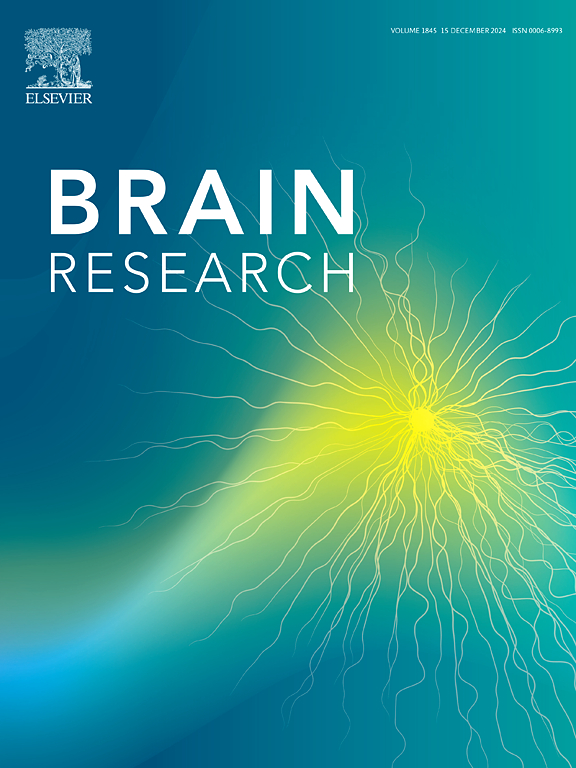Neuroprotection in pentylenetetrazol kindling rat model: A synergistic approach with eugenol and photobiomodulation
IF 2.7
4区 医学
Q3 NEUROSCIENCES
引用次数: 0
Abstract
Epilepsy is a complex neurological disorder characterized by recurrent seizures, significantly impacting patient health and quality of life. This study explores the neuroprotective effects of combining Eugenol (EUG), a natural bioactive compound administered at 100 mg/kg, with photobiomodulation (PBM), a non-invasive low-level laser therapy at 830 nm wavelength and 100 mW power, in a pentylenetetrazole (PTZ) kindling rat model of epilepsy. Fifty-nine adult male Wistar rats were assigned to five experimental groups: Control, PTZ (epilepsy model), PBM, EUG, and EUG + PBM. Seizure severity was assessed using a modified Racine scale following each PTZ injection. The study also evaluated cortical and hippocampal levels of brain-derived neurotrophic factor (BDNF), oxidative stress markers (MDA, NO, and GSH), activities of acetylcholinesterase (AChE) and Na + K + -ATPase, and monoamine neurotransmitters (DA, 5-HT, and NE). The results demonstrated that EUG and PBM, both individually and combined, significantly reduced seizure severity, mitigated oxidative stress, restored enzyme activities, and elevated BDNF levels. The combined treatment yielded superior neuroprotective effects compared to individual interventions, emphasizing its potential as a promising therapeutic strategy for epilepsy management.

戊四唑点燃大鼠模型的神经保护作用:丁香酚和光生物调节的协同作用
癫痫是一种以反复发作为特征的复杂神经系统疾病,严重影响患者的健康和生活质量。本研究探讨了丁香酚(EUG)(一种天然生物活性化合物,剂量为100 mg/kg)与光生物调节(PBM)(一种波长为830 nm、功率为100 mW的无创低强度激光治疗)联合对戊四唑(PTZ)点燃大鼠癫痫模型的神经保护作用。将59只成年雄性Wistar大鼠分为5个实验组:对照组、PTZ(癫痫模型)、PBM、EUG和EUG + PBM。每次注射PTZ后使用改良的拉辛量表评估癫痫发作的严重程度。该研究还评估了皮层和海马的脑源性神经营养因子(BDNF)、氧化应激标志物(MDA、NO和GSH)、乙酰胆碱酯酶(AChE)和Na + K + - atp酶的活性,以及单胺类神经递质(DA、5-HT和NE)的水平。结果表明,EUG和PBM,无论是单独使用还是联合使用,都能显著降低癫痫发作的严重程度,减轻氧化应激,恢复酶活性,提高BDNF水平。与单独干预相比,联合治疗产生了更好的神经保护作用,强调了其作为一种有前途的癫痫治疗策略的潜力。
本文章由计算机程序翻译,如有差异,请以英文原文为准。
求助全文
约1分钟内获得全文
求助全文
来源期刊

Brain Research
医学-神经科学
CiteScore
5.90
自引率
3.40%
发文量
268
审稿时长
47 days
期刊介绍:
An international multidisciplinary journal devoted to fundamental research in the brain sciences.
Brain Research publishes papers reporting interdisciplinary investigations of nervous system structure and function that are of general interest to the international community of neuroscientists. As is evident from the journals name, its scope is broad, ranging from cellular and molecular studies through systems neuroscience, cognition and disease. Invited reviews are also published; suggestions for and inquiries about potential reviews are welcomed.
With the appearance of the final issue of the 2011 subscription, Vol. 67/1-2 (24 June 2011), Brain Research Reviews has ceased publication as a distinct journal separate from Brain Research. Review articles accepted for Brain Research are now published in that journal.
 求助内容:
求助内容: 应助结果提醒方式:
应助结果提醒方式:


